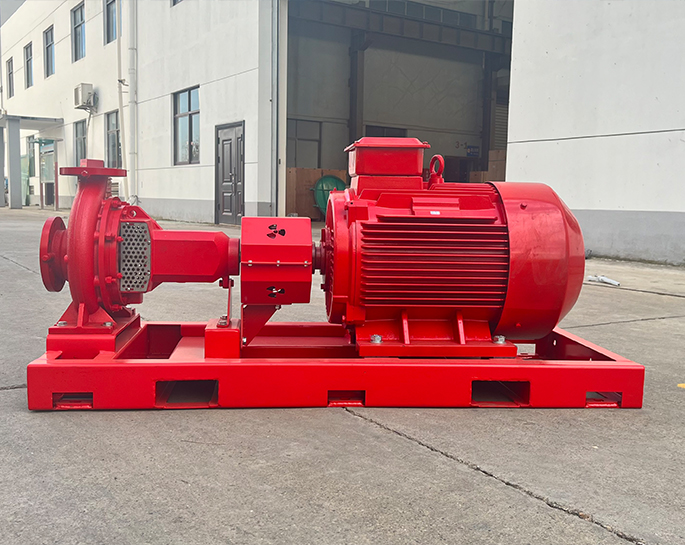How are fire pump flow control devices calibrated, and what is their role in the system?
Jan 11, 2024
Share:
Fire pump flow control devices play a crucial role in fire protection systems by regulating and controlling the flow of water from fire pumps to sprinkler systems or other firefighting equipment. Calibration of these devices ensures that they operate accurately and efficiently. Here's an overview of the calibration process and their role:
### Calibration of Fire Pump Flow Control Devices:
1. **Flow Meter Calibration:**
- Fire pumps often include flow meters to measure the rate of water flow. Calibration involves comparing the flow meter readings to a known standard.
- Flow meters may be calibrated using a calibrated test pump that provides a known flow rate.
2. **Pressure Relief Valve Calibration:**
- Pressure relief valves are calibrated to release excess pressure from the system. This involves setting the valve to open at a specific pressure level.
- Calibration is typically done using pressure gauges and adjusting the valve settings accordingly.
3. **Pressure Control Device Calibration:**
- Pressure control devices, such as pressure-reducing valves, are calibrated to maintain a consistent water pressure in the system.
- Calibration involves adjusting the valve settings to achieve the desired pressure levels.
4. **Testing Under Operating Conditions:**
- Flow control devices should be tested under actual operating conditions to ensure their performance meets the system requirements.
- This may involve conducting flow tests, pressure tests, and functional tests while the fire pump is in operation.
### Role of Fire Pump Flow Control Devices:
1. **Maintaining System Pressure:**
- Pressure control devices help maintain the required water pressure within the fire protection system. This ensures that sprinklers and other firefighting equipment receive an adequate water supply.

2. **Preventing Over-Pressurization:**
- Pressure relief valves prevent over-pressurization of the system, safeguarding it from potential damage and ensuring the system operates within safe limits.
3. **Flow Regulation:**
- Flow meters and other flow control devices regulate the flow of water from the fire pump. This is crucial for delivering the appropriate amount of water to different sections of the fire protection system.
4. **System Efficiency:**
- Properly calibrated flow control devices contribute to the overall efficiency of the fire protection system. This ensures that the system responds effectively in the event of a fire.
In summary, calibration is essential to ensure that fire pump flow control devices operate accurately and effectively. These devices play a critical role in maintaining the integrity and functionality of fire protection systems, helping to safeguard lives and property in the event of a fire.
### Calibration of Fire Pump Flow Control Devices:
1. **Flow Meter Calibration:**
- Fire pumps often include flow meters to measure the rate of water flow. Calibration involves comparing the flow meter readings to a known standard.
- Flow meters may be calibrated using a calibrated test pump that provides a known flow rate.
2. **Pressure Relief Valve Calibration:**
- Pressure relief valves are calibrated to release excess pressure from the system. This involves setting the valve to open at a specific pressure level.
- Calibration is typically done using pressure gauges and adjusting the valve settings accordingly.
3. **Pressure Control Device Calibration:**
- Pressure control devices, such as pressure-reducing valves, are calibrated to maintain a consistent water pressure in the system.
- Calibration involves adjusting the valve settings to achieve the desired pressure levels.
4. **Testing Under Operating Conditions:**
- Flow control devices should be tested under actual operating conditions to ensure their performance meets the system requirements.
- This may involve conducting flow tests, pressure tests, and functional tests while the fire pump is in operation.
### Role of Fire Pump Flow Control Devices:
1. **Maintaining System Pressure:**
- Pressure control devices help maintain the required water pressure within the fire protection system. This ensures that sprinklers and other firefighting equipment receive an adequate water supply.

2. **Preventing Over-Pressurization:**
- Pressure relief valves prevent over-pressurization of the system, safeguarding it from potential damage and ensuring the system operates within safe limits.
3. **Flow Regulation:**
- Flow meters and other flow control devices regulate the flow of water from the fire pump. This is crucial for delivering the appropriate amount of water to different sections of the fire protection system.
4. **System Efficiency:**
- Properly calibrated flow control devices contribute to the overall efficiency of the fire protection system. This ensures that the system responds effectively in the event of a fire.
In summary, calibration is essential to ensure that fire pump flow control devices operate accurately and effectively. These devices play a critical role in maintaining the integrity and functionality of fire protection systems, helping to safeguard lives and property in the event of a fire.

.png)
.png)

.png)


